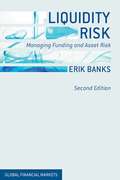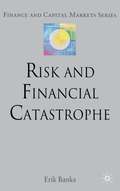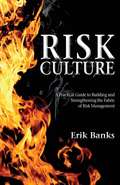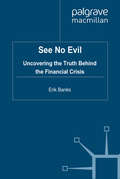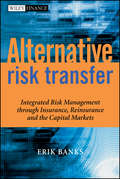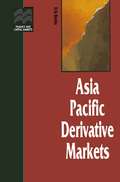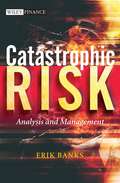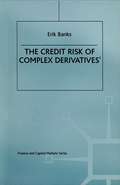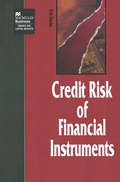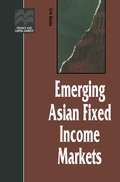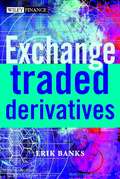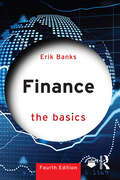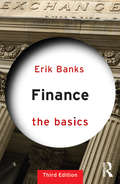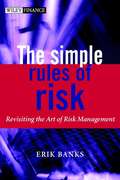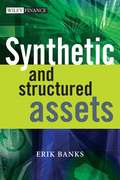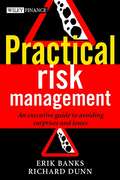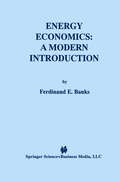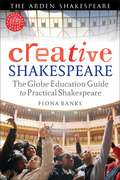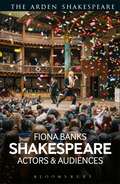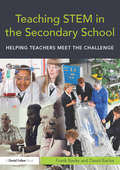- Table View
- List View
Liquidity Risk: Managing Funding and Asset Risk (Global Financial Markets)
by E. BanksLiquidity Management is now a core consideration for banks and other financial institutions following the collapse of numerous well-known banks in 2007-8. This timely new edition will provide practical guidance on liquidity risk and its management – now mandatory under new regulation.
Risk and Financial Catastrophe (Finance and Capital Markets Series)
by E. BanksThe risk process commonly used in the corporate world to deal with risks may be suitable for non-catastrophic events, but not for extreme events. By analyzing a series of past disasters and the relevant 'lessons learned', this books proposes a series of prescriptive measures to cope with future disasters.
Risk Culture: A Practical Guide to Building and Strengthening the Fabric of Risk Management
by E. BanksRisk Culture is a practical volume devoted to the qualitative aspects of risk management, including those that should be firmly embedded in the corporate culture. Through descriptions, examples and case studies, the book analyzes weak and strong cultures and proposes a series of structural and behavioral actions to strengthen a company's culture.
See No Evil: Uncovering The Truth Behind The Financial Crisis
by E. BanksThe story of the recent global economic crisis is told in the words of the main players in the drama. Including quotes from bankers, rating agencies, housing agencies, regulators, politicians and media figures. Erik Banks' latest book shows why we are doomed to experience further financial crises in the future.
Ernst Mach’s World Elements: A Study in Natural Philosophy (The Western Ontario Series in Philosophy of Science #68)
by E.C. BanksBy exploring Mach's views on science as well as philosophy, this book attempts to wrest him free from his customary association with logical positivism and to reinterpret him on his own terms as a natural philosopher and naturalist about human knowledge. Physicists, psychologists, philosophers of science, historians of twentieth-century thought and culture, and educators will find this volume a valuable help in interpreting Mach's ideas.
Alternative Risk Transfer: Integrated Risk Management through Insurance, Reinsurance, and the Capital Markets (The Wiley Finance Series)
by Erik BanksA practical approach to ART-an alternative method by which companies take on various types of risk This comprehensive book shows readers what ART is, how it can be used to mitigate risk, and how certain instruments/structures associated with ART should be implemented. Through numerous examples and case studies, readers will learn what actually works and what doesn't when using this technique. Erik Banks (CT) joined XL Capital's weather/energy risk management subsidiary, Element Re, as a Partner and Chief Risk Officer in 2001.
Asia Pacific Derivative Markets (Finance and Capital Markets Series)
by Erik BanksErik Banks, responsible for global risk management at Merrill Lynch in Hong Kong, has written another text on the derivatives field covering innovation in these instruments in Asia Pacific. The text acts as a detailed reference on the nature of these markets and the prospects for the Asian derivative markets, both listed and OTC. He also includes an analysis of the Australian, New Zealand and Japanese markets to fit the emerging markets into context.
Catastrophic Risk: Analysis and Management (The Wiley Finance Series)
by Erik BanksCatastrophic risk is one of the most significant and challenging areas of corporate risk management. Analyze this risk for your company with Catastrophic Risk and make sure you have sufficient resources to absorb losses and avoid financial distress. The first comprehensive volume to address this topic from a financial perspective, this book is a guide to the worst financial risks threatening companies and industries today. Author Eric Banks begins with a consideration of ?catastrophe? and its mplications, looks at the state of actuarial and financial modelling of catastrophe risks, and discusses the creation of a risk management framework that will enable the efficient and secure management of exposure. Catastrophic Risk is essential reading if you're a corporate treasurer, CFO, or insurance/financial risk manager responsible for corporate risk management. Order your copy today.
The Credit Risk of Complex Derivatives (Finance and Capital Markets Series)
by Erik BanksThis edition of The Credit Risk of Complex Derivatives is fully updated and enhanced. It discusses and analyses the credit risks of the new financial derivatives. The book commences with an overview of the regulatory environment and the renewed emphasis on risk Management. It then provides a comprehensive review of complex options and swaps, with extensive examples and illustrations. The text concludes with a detailed discussion of portfolio credit risk issues and techniques in order to ensure the most effective and accurate understanding of complex derivative credit risk.
The Credit Risk of Financial Instruments (Finance and Capital Markets Series)
by Erik BanksMarket volatility and competition have each played a significant role in altering the state of banking over the last twenty years. During the 1980s and 1990s banks have been exposed to new types of risks with far different characteristics and magnitudes than those dealt with in the early days of banking. Erik Banks seeks to explore the qualitative and quantitative aspects of risks attributable to financial instruments in today's markets, which are so much a part of banking business throughout the world. Banks describes the credit risks encountered in dealing with financial instruments and establishes a framework for quantifying the risks and applies framework and concepts on a product-by-product basis.
Emerging Asian Fixed Income Markets (Finance and Capital Markets Series)
by Erik BanksThe investor community is constantly looking for new sources of investment opportunity in the form of current income and capital gains. Much of the focus by fund managers, institutional investors and retail investors is currently on the global emerging markets of Asia where over $1 trillion of infrastructure and development projects will have to be funded over the next decade. In recent months, more institutions have been focusing on the fixed income markets, where returns have been impressive. The text from credit risk authority Erik Banks provides a detailed review of the emerging Asian fixed income markets and their primary instruments, along with a discussion of market participants, market mechanics and associated hedging and financing instruments.
Exchange-Traded Derivatives (The Wiley Finance Series)
by Erik BanksExchange-Traded Derivatives provides an overview of the global listed futures and options markets, and how individual exchanges and products are adapting to a new operating environment - an environment characterized by rapid, almost continuous, change. This book serves as an ideal resource on the 21st century listed derivative markets, products and instruments. Divided into three parts, Exchange-Traded Derivatives begins by providing an overall understanding of the marketplace and the forces that have, and are, altering the operating environment - stressing how exchanges need to change in order to cope with the challenges. The author then provides a comprehensive description of leading established exchanges, detailing their origins and structure, range of products and services, strengths and 'weaknesses'. The book concludes with a look at emerging marketplaces - those in developing countries as well as new "electronic" platforms - that are likely to increase in importance over the coming years. Exchange-Traded Derivatives is a valuable reference for fund managers, corporate treasurers, corporate risk managers, CFOs and those seeking a detailed guide to the world's derivative exchanges and products.
Finance: The Basics (The Basics)
by Erik BanksNow in its fourth edition, Finance: The Basics is a clear and practical introduction to the world of finance. It thoroughly explains essential financial statements, tools, and concepts; fundamental financial instruments and transactions; and global financial participants, markets, and systems. This fully revised edition captures the most important aspects of a changing financial landscape, including: • A new chapter dedicated to the emerging world of digital currencies, with a review of digital finance and a detailed discussion of regulated and unregulated digital currencies (including cryptocurrencies). • New sections dealing with a range of social issues that directly impact on finance, including sustainability; environmental, social, and governance (ESG) and socially responsible investing (SRI) imperatives; microfinance; and impact investing. • Twelve updated real-world case studies ('Finance in Action' studies) and nine new case studies focused on annuities, sustainability, green financings, microfinance, digital currencies, financial technology/decentralised finance, ESG and SRI investing, quantitative easing and tightening, and the financial emergence of China. • A concise and comprehensive glossary containing key terms discussed in the book. • Supplemental digital resources, including PowerPoints for instructors and a test bank of questions for students. Each chapter is accompanied by an overview and summary, illustrations and tables, real-life case studies, and recommended readings. Finance: The Basics is essential reading for anyone interested in the fascinating world of finance.
Finance: The Basics (The Basics #486)
by Erik BanksNow in its fourth edition, Finance: The Basics is a clear and practical introduction to the world of finance. It thoroughly explains essential financial statements, tools, and concepts; fundamental financial instruments and transactions; and global financial participants, markets, and systems. This fully revised edition captures the most important aspects of a changing financial landscape, including: • A new chapter dedicated to the emerging world of digital currencies, with a review of digital finance and a detailed discussion of regulated and unregulated digital currencies (including cryptocurrencies). • New sections dealing with a range of social issues that directly impact on finance, including sustainability; environmental, social, and governance (ESG) and socially responsible investing (SRI) imperatives; microfinance; and impact investing. • Twelve updated real-world case studies ('Finance in Action' studies) and nine new case studies focused on annuities, sustainability, green financings, microfinance, digital currencies, financial technology/decentralised finance, ESG and SRI investing, quantitative easing and tightening, and the financial emergence of China. • A concise and comprehensive glossary containing key terms discussed in the book. • Supplemental digital resources, including PowerPoints for instructors and a test bank of questions for students. Each chapter is accompanied by an overview and summary, illustrations and tables, real-life case studies, and recommended readings. Finance: The Basics is essential reading for anyone interested in the fascinating world of finance.
Finance: The Basics (The Basics)
by Erik BanksNow in its third edition, Finance: The Basics is a clear and practical introduction to the world of finance. It thoroughly explains essential financial statements, tools and concepts; fundamental financial instruments and transactions; and global financial participants, markets and systems. This fully revised third edition captures the most important aspects of a changing financial landscape, including: • Updates on key areas of the financial system, including default experience, corporate finance trends, growth in dark pools, hedge funds, foreign exchange and derivatives, and changes to the international regulatory and central banking framework. • Further real-world examples/studies that introduce, or expand upon, a range of practical topics; 12 updated studies are supplemented by new cases related to reinsurance, central bank quantitative easing and digital currency and payments. • A comprehensive glossary containing key terms discussed in the book. Each chapter is accompanied by an overview and summary, illustrations and tables, real life case studies, and recommended readings. Finance: The Basics is essential reading for anyone interested in the fascinating world of finance.
Finance: The Basics (The Basics)
by Erik BanksNow in its third edition, Finance: The Basics is a clear and practical introduction to the world of finance. It thoroughly explains essential financial statements, tools and concepts; fundamental financial instruments and transactions; and global financial participants, markets and systems. This fully revised third edition captures the most important aspects of a changing financial landscape, including: • Updates on key areas of the financial system, including default experience, corporate finance trends, growth in dark pools, hedge funds, foreign exchange and derivatives, and changes to the international regulatory and central banking framework. • Further real-world examples/studies that introduce, or expand upon, a range of practical topics; 12 updated studies are supplemented by new cases related to reinsurance, central bank quantitative easing and digital currency and payments. • A comprehensive glossary containing key terms discussed in the book. Each chapter is accompanied by an overview and summary, illustrations and tables, real life case studies, and recommended readings. Finance: The Basics is essential reading for anyone interested in the fascinating world of finance.
The Simple Rules of Risk: Revisiting the Art of Financial Risk Management (The Wiley Finance Series)
by Erik BanksIn an age where companies and financial institutions are keenly focused on managing the financial risk of their operations, the implementation of quantitative methods and models has been of tremendous help. Tools such as VaR, credit VaR, risk-adjusted returns, and scenario analyses have given institutions the means to quantify and understand their risk profiles. However, the focus on quantitative risk management, while important, can sometimes be over-emphasized--at the expense of logic and experience. At its core, the successful management of risk is still largely an "art." The Simple Rules of Risk takes a fresh look at the qualitative aspects of risk management. It also considers how qualitative approaches can make optimal use of the mathematical aspects of risk management to create the most effective framework possible.
Synthetic and Structured Assets: A Practical Guide to Investment and Risk (The Wiley Finance Series)
by Erik BanksOrganized along product lines, the book will analyze many of the original classes of structured assets, including mortgage- and asset-backed securities and strips, as well as the newest structured and synthetic instruments, including exchange-traded funds, credit derivative-based collateralized debt obligations, total return swaps, contingent convertibles, and insurance-linked securities. Two introductory chapters will outline the scope of the market, key definitions, participant motivations/goals, economics of structuring and synthetic replication, and the central "building blocks" used in the creation of synthetic/structured assets (including on-balance sheet assets and liabilities, derivatives, shelf registration debt programs, private placements, trusts, and special purpose entities). Eight product chapters will then examine the main instruments of the marketplace: mortgage- and asset-backed securities, stripped/reconstituted government securities, collateralized debt obligations, structured notes, insurance-linked securities, exchange-traded funds, convertible bond variations, and derivatives/synthetic asset replication. Each product chapter will contain product descriptions, structural features (e.g., trading conventions, settlement), arbitrage/investment drivers, and various worked examples and diagrams that emphasize practical investment and risk applications; financial mathematics will be kept to a minimum. A concluding chapter will review the essential risk, legal, regulatory, and accounting features of synthetic and structured assets in the world's major markets.
Practical Risk Management: An Executive Guide to Avoiding Surprises and Losses (The Wiley Finance Series)
by Erik Banks Richard DunnA proven way to manage risk in today's business world Understanding how the risk process works is a critical concept that business professionals must come to learn. For those who must understand the fundamentals of risk management quickly, without getting caught up in jargon, theory, mathematics, and formulas, Practical Risk Management is the perfect read. Written in a clear, fast-paced and easily digestible style, this book explains the practical challenges associated with risk management and how-by focusing on accountability, governance, risk appetite, liquidity, client risks, automated and manual processes, tools and diagnostics-they can be overcome. After finishing this book, readers will have a solid understanding of the risk process, know which issues/questions are of critical importance, and be able to determine how their specific risk problems can be minimized or avoided. Erik Banks (Redding, CT) is currently Chief Risk Officer for Element Re. Prior to that he spent several years at Merrill Lynch in market/credit risk management roles in London, Tokyo, Hong Kong, and the United States. He is also adjunct Professor of Finance at the University of Connecticut, where he teaches MBA students. Richard Dunn (London, UK) works for Merrill Lynch. He single-handedly restructured Merrill Lynch's risk function post in 1998 into its current form.
Energy Economics: A Modern Introduction
by Ferdinand E. Banks"Energy is the go of things", as James Clerk Maxwell pointed out. This th simple truth was largely overlooked during the first 70 years of the 20 century, because in the industrial world most politicians, civil servants, and opinion makers were inclined to believe that virtually an infinite supply of reasonably priced energy would always be available, and so things would continue to 'go' in the manner to which many of their constituents and admirers had become accustomed. Similar opinions were held about fresh air, and water for consumption and agricultural uses. As a result, it was not until the last two decades of the century that serious courses in energy and environmental economics began to be offered at institutions of higher learning around the world. This book is intended as a comprehensive introductory text and/or reference book for courses of this nature having to do with energy economics. (I have also attempted to make the book useful for self study. ) As far as I know, there are no energy economics text or reference books on the level of this book in the English language. Needless to say, if I am wrong then I apologise to their authors; but right or wrong, I would like to see more energy economics books of all descriptions now. We cannot afford to have the same kind of mistakes made with energy policy that (in much of the world) are being made with e. g. employment policy.
Creative Shakespeare: The Globe Education Guide to Practical Shakespeare
by Fiona BanksThis unique book desribes the ways in which educational practitioners at Shakespeare's Globe theatre bring Shakespeare to life for students of all ages.The Globe approach is always active and inclusive - each student finds their own way into Shakespeare - focussing on speaking, moving and performing rather than reading. Drawing on her rich and varied experience as a teacher, Fiona Banks offers a range of examples and practical ideas teachers can take and adapt for their own lessons. The result is a stimulating and inspiring book for teachers of drama and English keen to enliven and enrich their students' experience of Shakespeare.
Creative Shakespeare: The Globe Education Guide to Practical Shakespeare
by Fiona BanksThis unique book desribes the ways in which educational practitioners at Shakespeare's Globe theatre bring Shakespeare to life for students of all ages.The Globe approach is always active and inclusive - each student finds their own way into Shakespeare - focussing on speaking, moving and performing rather than reading. Drawing on her rich and varied experience as a teacher, Fiona Banks offers a range of examples and practical ideas teachers can take and adapt for their own lessons. The result is a stimulating and inspiring book for teachers of drama and English keen to enliven and enrich their students' experience of Shakespeare.
Shakespeare: Actors and Audiences
by Fiona BanksShakespeare: Actors and Audiences brings together the voices of those who make productions of Shakespeare come to life. It shines a spotlight on the relationship between actors and audiences and explores the interplay that makes each performance unique. We know much about theatre in Shakespeare's time but very little about the audiences who attended his plays. Even today the audience's voice remains largely ignored. This volume places the role of the audience at the centre of how we understand Shakespeare in performance. Part One offers an overview of the best current audience research and provides a critical framework for the interviews and testimony of leading actors, theatre makers and audience members that follow in Part Two, including Juliet Stevenson and Emma Rice. Shakespeare: Actors and Audiences offers a fascinating insight into the world of theatre production and of the relationship between actor and audience that lies at the heart of theatre-making.
Shakespeare: Actors and Audiences
by Fiona BanksShakespeare: Actors and Audiences brings together the voices of those who make productions of Shakespeare come to life. It shines a spotlight on the relationship between actors and audiences and explores the interplay that makes each performance unique. We know much about theatre in Shakespeare's time but very little about the audiences who attended his plays. Even today the audience's voice remains largely ignored. This volume places the role of the audience at the centre of how we understand Shakespeare in performance. Part One offers an overview of the best current audience research and provides a critical framework for the interviews and testimony of leading actors, theatre makers and audience members that follow in Part Two, including Juliet Stevenson and Emma Rice. Shakespeare: Actors and Audiences offers a fascinating insight into the world of theatre production and of the relationship between actor and audience that lies at the heart of theatre-making.
Teaching STEM in the Secondary School: Helping teachers meet the challenge
by Frank Banks David BarlexThe skills, knowledge and understanding of the subjects involved in STEM (Science, Technology, Engineering and Mathematics) are vital for all young people in an increasingly science- and technology-driven society. This book looks at the purpose and pedagogy of STEM teaching and explores the ways in which STEM subjects can interact in the curriculum to enhance student understanding, achievement and motivation. By reaching outside their own classroom, teachers can collaborate across subjects to enrich learning and help students relate school science, technology and maths to the wider world. Packed with ideas and practical details for teachers of STEM subjects, this book: considers what the STEM subjects contribute separately to the curriculum and how they relate to each other in the wider education of secondary school students describes and evaluates different curriculum models for STEM suggests ways in which a critical approach to the pedagogy of the classroom, laboratory and workshop can support STEM for all students addresses the practicalities of introducing, organising and sustaining STEM-related activities in the secondary school looks to ways schools can manage and sustain STEM approaches in the long-term. This timely new text is essential reading for trainee and practising teachers who wish to make the learning of Science, Technology, Engineering and Mathematics an interesting, motivating and exciting experience for their students.
